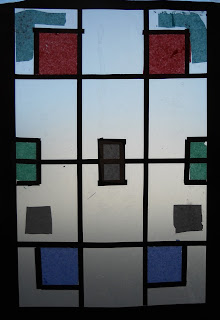And the new video can be viewed below OR on youtube. ENJOY!
------------------------------------------------------------------------------
This is a great project that uses only a couple of supplies (and a bit of patience) to create a piece that transforms from "ho-hum" into "WOW!" This is a great way to illustrate how various lines can show movement.
Horizontal lines are sleepy and calm. Vertical lines are strong and stand still, but diagonal lines seem to slide and move, bringing our eye from one side of the page to the other and then "whoosh!" off the page! We start off this exercise by using the ruler to create a series of diagonal lines and color them in with markers. Then, we cut the piece up and fan the strips out and create another type of line...a swirly, curving line that also shows movement! This is also a nice op-art activity. You can use complementary colors for your diagonal lines or a full rainbow of color. Experiment and enjoy the process!
Movement With Lines
Supplies Needed:
- One sheet of white construction paper, 9"x12"
- One sheet of black construction paper, 12"x18"
- Ruler
- Pencil and eraser
- Markers, assorted colors
- Glue sticks
Directions:
1. Draw a series of diagonal lines on the white construction paper. You can draw three smaller lines going across the page or fill the space with lines. Both look great, in my opinion.
2. Color in the diagonal lines using markers.
3. Flip the page over and divide the page into twenty-four 1/2" wide strips. Use your ruler for this and try to be as precise as possible. BEFORE you cut the strips apart, number them on the back from 1-24 at one end (the same end of the strips for all numbers).
 |
| This photo is kind of hard to see, but it shows all of the strips numbered on the back at the same end. |
Now, this is where it gets a little bit tricky. I'm sure you can do this many ways, but I made three of these and I finally landed on this way of doing it.
4. Cut out the strip marked #12. Put glue on the back and glue it on your black construction paper background in the middle, like this:
4. Cut out the strip marked #12. Put glue on the back and glue it on your black construction paper background in the middle, like this:
5. Now you can cut strip #11 out and put glue on the back of it. Overlap the left edge of the strip over the left edge of the previous strip (in this case, strip #12), fanning the right edge out slightly (about 1/2"). Repeat with strips 10-1 (working away from you) until you get through strip #1, forming a nice curve with the strips. Use the photo as a guide.
7. Once you have finished gluing down strip #1. Place glue on the back of strip #13 and overlap the right edge of the strip over the right edge of strip #12, fanning the left edge down slightly (about 1/2").
8. Repeat with strips 14-24 until you get through all the strips, forming a nice curve in the opposite direction with the strips. Use the picture as a guide.
It is OK if the ends of the strips continue off the edge of the page. You can leave them that way or trim them to the edge of the black construction paper.
It is OK if the ends of the strips continue off the edge of the page. You can leave them that way or trim them to the edge of the black construction paper.
This project is good for the older child since they may be more tolerant of cuting up their artwork and transforming it into something else. Also, they are more capable of handling the precise measuring and cutting this project needs in order to be successful. It took me three times to get all the strips to fit on the black construction paper properly. But I really liked all of the other attempts I made too. It's an experiment, so don't get too stressed!
Enjoy!






























